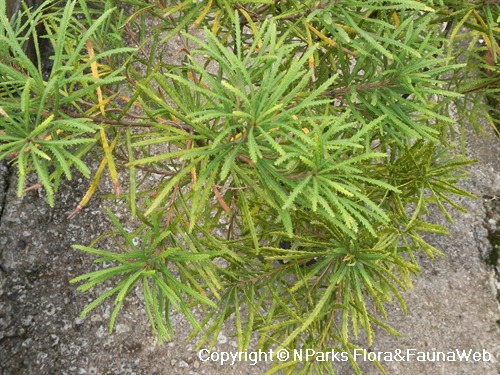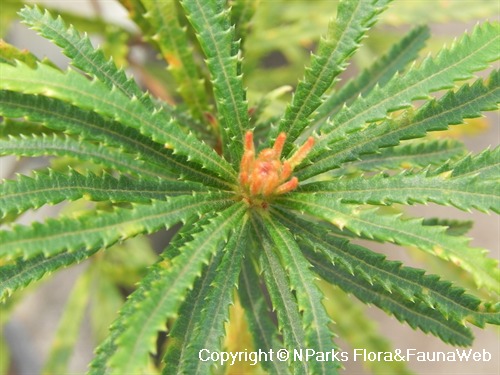
Back
Banksia spinulosa
| Family Name: | Proteaceae |
| Synonyms: | Banksia denticulata, Banksia incognita, Sirmuellera spinulosa |
| Common Name: | Hairpin Banksia |
Hairpin Banksia (Banksia spinulosa) has interesting flower spikes of orange, red and gold. In its native region, it is propagated via seeds or stem cuttings on well-drained soils. This shrub attracts bees and nectar-feeding birds.
Name
Classifications and Characteristics
| Plant Division | Angiosperms (Flowering Seed Plants) |
|---|---|
| Plant Growth Form | Shrub |
| Lifespan (in Singapore) | Perennial |
| Mode of Nutrition | Autotrophic |
| Plant Shape | Rounded, Shrubby |
Biogeography
| Native Distribution | New South Wales, Queensland |
|---|---|
| Native Habitat | Terrestrial (Coastal Forest, Mountain) |
| Local Conservation Status | Non-native (Horticultural / Cultivated Only) |
Description and Ethnobotany
| Growth Form | Perennial shrub that grows from 1 - 3 m tall. |
|---|---|
| Foliage | Leaves are long and narrow, measuring from 3-8 cm long by 2-7 mm wide, and leaf edges are variably toothed. |
| Flowers | Flowers borne in clusters called spikes that are about 10 - 20 cm in length. Flower colours vary from brown, red, orange to gold. The flower opens from the tip of the spike. |
| Cultivation | In its native habitat, the plant is propagated from seed which can be sown all year round. Germination occurs two to five weeks after sowing. |
| Etymology | The genus epithet Banksia is named after Sir Joseph Banks, the President of the Royal Society. The specific epithet spinulosa means bearing small spines, which most likely refers to the leaf tip when the plant was originally described. |
Landscaping Features
| Desirable Plant Features | Ornamental Flowers |
|---|---|
| Landscape Uses | Parks & Gardens |
Plant Care and Propagation
| Light Preference | Full Sun |
|---|---|
| Water Preference | Moderate Water |
| Plant Growth Rate | Moderate |
| Rootzone Tolerance | Moist Soils, Well-Drained Soils |
| Planting Remarks | Plants grown from seed take two to three years before flowering, and from five to six years to attain their full height. |
| Propagation Method | Seed, Stem Cutting |
| Propagation Method Remarks | The seed can remain viable for several years. Propagation from cuttings is used when one wishes to retain specific colour forms. |
Foliar
| Foliage Retention | Evergreen |
|---|---|
| Mature Foliage Colour(s) | Green |
| Foliar Type | Simple / Unifoliate |
| Foliar Attachment to Stem | Sessile |
| Foliar Shape(s) | Non-Palm Foliage (Linear) |
| Foliar Margin | Spiny |
Floral (Angiosperm)
| Flower Colour(s) | Brown, Red, Orange, Yellow / Golden |
|---|---|
| Flower Grouping | Cluster / Inflorescence |
| Inflorescence Type | Spike |
| Flower Lifespan on Plant | In its native habitat, flowers last from autum, through winter to spring |
| Flowering Habit | Polycarpic |
Image Repository
Others
| Master ID | 30559 |
|---|---|
| Species ID | 4868 |
| Flora Disclaimer | The information in this website has been compiled from reliable sources, such as reference works on medicinal plants. It is not a substitute for medical advice or treatment and NParks does not purport to provide any medical advice. Readers should always consult his/her physician before using or consuming a plant for medicinal purposes. |

